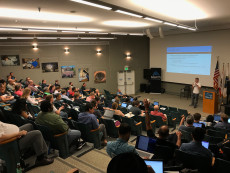NERSC Hosts 2017 Slurm User Group Meeting
With 85 attendees from around the world, it was the largest SLUG meeting to date
October 3, 2017
NERSC hosted the 2017 Slurm User Group (SLUG) meeting September 24-26 at Berkeley Lab—the largest SLUG meeting to date, with 85 attendees from the U.S., Europe and Australia.
Slurm (Simple Linux Utility for Research Management) is an open-source workload management and scheduling system developed and supported primarily by SchedMD, which was founded in 2010 to create and provide services around Slurm. Initially developed for large Linux clusters at Lawrence Livermore National Laboratory, Slurm is currently used on NERSC’s Cori and Edison systems and is increasingly being adopted by supercomputing facilities around the world.
“The rapid adoption of SchedMD’s Slurm resource manager is due in part to the vibrant and expanding Slurm User Group,” said David Paul of NERSC’s Computational Systems Group, who helped organize the event along with NERSC staffers Jackie Scoggins, Kerry Peyovich, Basil Lali and Tony Quan. “Not only is the number of attendees growing, the sites and companies represented is expanding to include prominent labs, universities and research centers from around the world.”
This year’s attendees came from major universities, including U.C. Berkeley, Stanford, MIT, Harvard, University of Michigan, BYU and NYU; national labs, including Lawrence Livermore, Sandia and Oak Ridge; and industry, including Novartis, Genentech, Cray and Roche. Representatives from several major European computing centers also attended, including CSCS (Switzerland), FZ-Juelich (Germany), AWE (England), CEA France and Bull/Atos (France).
The two-day SLUG event featured a keynote by Berkeley Lab’s Alex Kim on “Supernova Cosmology and Supercomputing” and more than 20 technical talks and site reports, including three by NERSC staff:
- Nagios Plugins for Node Monitoring & KNL reboot, Basil Lalli and Tony Quan
- cli_filter plugin for client-side job filtration and manipulation, Doug Jacobsen
- NERSC site report, James Botts and Doug Jacobsen
“An active and engaged user group contributes to an improved product with additional functionality and fewer bugs (or faster bug fixes), which in turn leads to further adoption and expansion of the installed base,” Paul said. For a complete list of speakers and abstracts, click here.
In a non-technical moment during the meeting, Nick Cardo, a former NERSC employee who is now at CSCS, donated a premium box of Swiss chocolates that was raffled off, with the proceeds to benefit the Mexico earthquake relief fund. The raffle raised $340, which will be made on behalf of SLUG. Cardo has family in the Mexico City area that was directly impacted by the September 19 earthquake.
About NERSC and Berkeley Lab
The National Energy Research Scientific Computing Center (NERSC) is a U.S. Department of Energy Office of Science User Facility that serves as the primary high performance computing center for scientific research sponsored by the Office of Science. Located at Lawrence Berkeley National Laboratory, NERSC serves almost 10,000 scientists at national laboratories and universities researching a wide range of problems in climate, fusion energy, materials science, physics, chemistry, computational biology, and other disciplines. Berkeley Lab is a DOE national laboratory located in Berkeley, California. It conducts unclassified scientific research and is managed by the University of California for the U.S. Department of Energy. »Learn more about computing sciences at Berkeley Lab.








